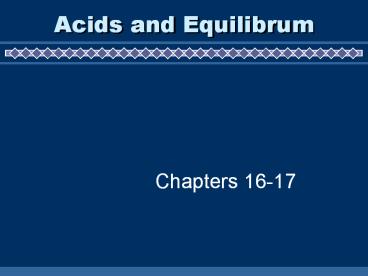Acids and Equilibrum - PowerPoint PPT Presentation
1 / 37
Title: Acids and Equilibrum
1
Acids and Equilibrum
Chapters 16-17
2
- Acids
3
A. Properties
ACIDS
BASES
- electrolytes ? electrolytes
- sour taste
- bitter taste
- turn litmus red
- turn litmus blue
- react with metals to form H2 gas
- slippery feel
- vinegar, milk, soda, apples, citrus fruits
- ammonia, lye, antacid, baking soda
ChemASAP
4
The Arrhenius Model
- Acid produces hydrogen ions in aqueous solution
- Base produces hydroxide ions in aqueous
solution
5
Acids
- Acids have Hydrogen atom in them
- Give off H
- Examples
- HCl
- H2SO4
- Even H2O
HCl ? H Cl-
H2SO4 ? 2H SO4-2
H2O ? H OH-
6
Bases
- Have OH (Called hydroxide) in them
- Examples
- NaOH
- Ca(OH)2
- Even H2O
NaOH ? Na OH-
Ca(OH)3 ? Ca 2OH-
H2O ? H OH-
7
The Bronsted-Lowry Model
- Acid proton donor
- Base proton acceptor
- The general reaction for an acid dissolving in
water is
8
The Bronsted-Lowry Model
- Conjugate acid-base pair
Always in pairs acids need a base to accept
proton.
9
The Bronsted-Lowry Model
- Water acts as a base accepting a proton from the
acid. - Forms hydronium ion (H3O)
10
Water is amphoteric
- Can act as both acid and base
- Can produce both H
- And also OH-
11
Monoprotic and Polyprotic
- Monoprotic - Give off only one H
- HCl
- HNO3
- even HC2H3O2
- Polyprotic - Give off more than one H
- H2SO3
12
Acid Strength
- Strong acid completely ionized or completely
dissociated
13
Strong Acid
- HCl ? H Cl-
- Mostly H Cl- ions
- Very little HCl molecule in solution.
14
Strength
- Strong Acid/Base
- 100 ionized in water
- strong electrolyte
HCl HNO3 H2SO4 HBr HI HClO4
NaOH KOH Ca(OH)2 Ba(OH)2
15
B. Acid Strength
- Weak acid most of the acid molecules remain
intact
16
Acid Strength
- Common strong acids are
- Sulfuric acid, H2SO4
- Hydrochloric acid, HCl
- Nitric acid, HNO3
- Perchloric acid, HClO4
17
Strength
- Weak Acid/Base
- does not ionize completely
- weak electrolyte
HF CH3COOH H3PO4 H2CO3 HCN
NH3
18
Strong and Weak
- Strong and weak are not the same as Concentrated
and dilute - Strong means
- Concentrated means
Can a concentrated acid solution be weak?
19
Water as an Acid and a Base
- Water is amphoteric it can behave as either an
acid or as a base - Ionization of water
- Concentration of hydronium and hydroxide are
equal
20
Acids and Bases
21
PH
- Used to measure strength of an Acid or Base
22
The pH Scale
- The p scale is used to express small numbers.
- pH ?log H
23
The pH Scale
24
The pH Scale
- Because the pH scale is a log scale based on 10,
the pH changes by 1 for every power of 10 change
in the H.
25
B. pH Scale
0
14
7
INCREASING ACIDITY
INCREASING BASICITY
NEUTRAL
pH -logH3O
26
pH Scale
- pH of Common Substances
27
pH Scale
pH -logH3O pOH -logOH- pH pOH 14
28
pH Scale
- Lower the pH means STRONGER the acid
- This means more H ions in solution
- This is the ion that makes acid act like an acid
- Each one unit change is 10 times stronger
29
A. The pH Scale
30
B. pH Scale
- What is the molarity of HBr in a solution that
has a pH of 4.4?
Acidic
pH -logH 4.4 -logH -4.4
logH H3O 4.0 ? 10-5 M HBr
31
Measuring pH
- Indicators substances that exhibit different
colors in acidic and basic solutions
32
Universal Indicator
33
Measuring pH
- Other methods
- Indicator paper
- pH meter
34
Mixing an acid and a base
- Neutralization Reaction
Acid Base ? Water and salt HCl NaOH
? H2O NaCl
neutral
Strong Acid Strong Base Strong Acid Weak
Base Weak Acid Strong Base Weak acid
weak base
slightly acidic
slightly basic
neutral
35
Acid-Base Titrations
- Titration delivering a measured volume of a
solution of known concentration into the solution
being analyzed - Titrant a standard solution
- Buret device used for accurate measurement of
the delivery of a liquid - Stoichiometric point (equivalence point) when
just enough titrant has been added to react with
all of the solution being analyzed
36
Acid-Base Titrations
- Titration curve (pH curve) plot of the data (pH
vs volume) for a titration
37
Buffered Solutions
- Buffered solution resists a change in its pH
when either and acid or a base has been added - Presence of a weak acid and its conjugate base
buffers the solution

